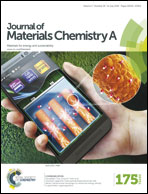Achieving high-efficiency and ultrafast removal of Pb(ii) by one-pot incorporation of a N-doped carbon hydrogel into FeMg layered double hydroxides†
Abstract
Lead (Pb) is one of the most widespread toxic heavy metals in water distribution systems and surface water, and how to quickly and completely remove Pb from the water has received global concern. Here we designed and synthesized a 3D nitrogen doped carbon hydrogel/FeMg layered double hydroxide (NC–FeMg LDH) nanocomposite through a one-pot solvothermal process and investigated the Pb removal efficiency and underlying mechanism. Multiple characterization methods including XRD, FTIR, and TEM confirmed that the 3D NC–FeMg LDH is formed by incorporating 2D FeMg-LDH nanosheets with the nitrogen doped carbon hydrogel which is in situ formed in the solvothermal carbonization of glucosamine. The as-synthesized 3D NC–FeMg LDH shows favorable performance in the removal of Pb from aqueous solution with very short equilibrium time (2 min) and large adsorption capacity (344.8 mg g−1). The excellent removal performance toward Pb is demonstrated to be a structure-dependent multiplex surface chemical process between Pb and LDH involving Mg2+/Pb2+ ion exchange, Pb/C![[double bond, length as m-dash]](https://www.rsc.org/images/entities/char_e001.gif) O or O
O or O![[double bond, length as m-dash]](https://www.rsc.org/images/entities/char_e001.gif) C–O, and Pb/pyrrolic N surface complexation. This work may provide an idea for designing hybrid functional materials for selective and high-efficiency removal of other heavy metals from polluted water.
C–O, and Pb/pyrrolic N surface complexation. This work may provide an idea for designing hybrid functional materials for selective and high-efficiency removal of other heavy metals from polluted water.


 Please wait while we load your content...
Please wait while we load your content...